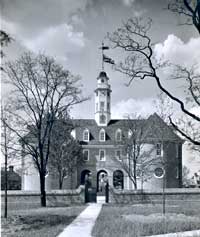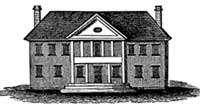The Colonial Capitol
No images exist to document the statehouses built for the General Assembly of the colony of Virginia, the first representative government in English-speaking North America. At its first meeting on 30 July 1619, the General Assembly met in the "quire" of the Jamestown church. In 1641 the assembly moved into a building owned by former governor Sir John Harvey. Fire destroyed the assembly's meeting spaces in 1655 and in 1657. Shortly after 1663 the General Assembly, then consisting of the governor's Council and the House of Burgesses, met in a new statehouse, but that building was burned in 1676 when Nathaniel Bacon destroyed Jamestown. By 1685 the General Assembly had a new statehouse that included a porch. The building burned on Halloween 1698, and the government abandoned Jamestown for Middle Plantation, site of the newly chartered College of William and Mary.

First Capitol at Williamsburg
Built between 1701 and 1705, the first Williamsburg statehouse served the colony of Virginia until fire destroyed the building in 1747. The first floor of the distinctive brick two-and-a-half story H-plan Capitol consisted of two large chambers connected by a central open arcade or "piazza." The plan with ceremonial entry that led through the portico into the side of the courtroom set the standard for subsequent Virginia Capitols. Beyond the court stood an informal meeting space and the lower house of the assembly, the House of Burgesses. The upper house, or governor's Council, met on the second floor at the opposite end of the building over the courtroom.

Second Capitol at Williamsburg
The second Capitol at Williamsburg was built between 1751 and 1753 on the foundations of the first. It had a similar first floor plan with a ceremonial entry through the portico into the side of the courtroom. Rather than repeat the projecting semicircular apses and porticoes of the first Capitol, the builders constructed a two-tiered rectangular portico onto the main facade. Derived from designs for houses by the Italian Renaissance architect Andrea Palladio (1508-1580), the portico of the new Capitol inspired imitations in a series of Virginia houses, such as Jefferson's first design for Monticello.